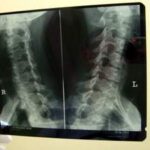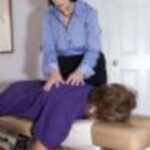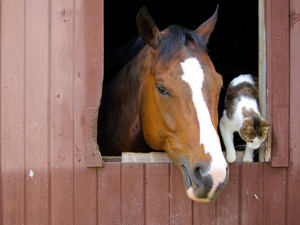Many people are afraid to visit a chiropractor for neck problems, and I used to be one of those people. I had surgery for cervical spinal stenosis approximately six years ago, and I’ve occasionally suffered extreme pain, numbness, and discomfort ever since. Until I became desperate for relief I never sought the services of a chiropractor, and I discounted their abilities as so many others do. I had heard the term quack-o-practor many times, and since chiropractors aren’t medical doctors, the medical community doesn’t recognize or promote their capabilities. The following is a personal account of how I found relief when suffering with pain and numbness caused by cervical spinal stenosis.
Precautionary Statement
Those with cervical fusions should not have complete chiropractic adjustments. Provide your chiropractor with a complete history of any medical problems or procedures in advance of spinal treatments or adjustments of any type. If you’ve never had a complete physical examination to determine your particular problem, visit a doctor specializing in diseases of the spine before seeking chiropractic treatment. A MRI might be necessary in determining the exact cause of the symptoms you’re experiencing.
A Brief History of My Condition
As previously mentioned, I have cervical spinal stenosis. An injury didn’t bring on this debilitating physical condition. I was born with cervical spinal stenosis, and it’s a degenerative disease that progressively closes the openings for the nerves. Although I’ve had surgery to enlarge the openings for the nerves in cervical discs 4, 5, and 6, I still experience pain, weakness, and numbness.
As a result of cervical spinal stenosis, my nerves were permanently damaged, and the muscles in my arms were compromised. I went to therapy after surgery, but I still have a difficult time lifting with my right arm, and if I lift more than I should, I suffer for days thereafter. My right wrist, which used to be my stronger side, isn’t strong enough to support a gallon of milk or anything similar. I occasionally experience muscle pain in my shoulders and up the back of my neck, and I suffer from excruciating headaches as a result. These headaches often cause vomiting, and I become debilitated for hours and sometimes days on end.
I’ve experienced numbness in my right hand since shortly before my cervical spinal stenosis surgery, and extreme numbness and tingling suddenly came on in my left arm before moving to my new home. I probably lifted too much in the process of packing and pinched other nerves in my neck. I had already permanently lost feeling in my right thumb as a result of cervical spinal stenosis, and I thought for sure I would require more surgery after I began experiencing problems with my left arm. At age 41 I couldn’t imagine what life would be like if I made it to age 70 or 80. I was already miserable, and my quality of life was waning. I was becoming increasingly depressed.
Visiting a Chiropractor
My medical doctor told me to never go to a chiropractor to have my neck adjusted, because one slip and I could have permanent damage. I already have permanent damage caused by cervical spinal stenosis, and one day while suffering and vomiting as a result of the pain, my husband suggested going to the chiropractor for an adjustment. He’s a truck driver, and he goes to a chiropractor about once a month to have his spine adjusted, but I was hesitant because of my cervical spinal stenosis and the warnings I had received. After considering the situation, I decided I really didn’t have anything to lose but the pain. I was already suffering tremendous discomfort, and I was desperate for relief. Even the narcotic pain pills and muscle relaxers I take on a regular basis don’t alleviate the pain when it becomes severe.
The chiropractor said that medical doctors don’t usually recommend their services, but as long as the discs haven’t been fused, he said it’s safe to have an adjustment. The walls in the chiropractor’s office displayed pictures of spinal x-rays detailing degenerative disc disease, and this was all the convincing I needed. I didn’t want further surgery, which the neurosurgeon would have gladly performed once again, and an adjustment was a last ditch effort to find the relief I so desperately needed.
It was startling when the chiropractor adjusted my neck, but it wasn’t painful. The discs in my neck cracked so strongly and loudly that it scared me at first. I stiffened up after I was asked to turn to the other side. The chiropractor told me I would have to relax for the procedure to work. I relaxed my head in the palm of his hand, and he adjusted my neck from the other side. My discs in my neck cracked once again, but not as loudly. It was obvious that my neck had been way out of line.
After the adjustment I felt like I had been pulled through a knothole, and I relaxed the rest of the day while applying ice to my cervical spine. Even still I felt better than I had. The next day I woke up feeling better than I have in years, and since the chiropractor first adjusted my neck, I haven’t had the numbness and tingling in my left arm.
Massages and Pain Pills?
Even though my doctor warned that going to a chiropractor isn’t safe, I will continue to go to my chiropractor. The doctor was never able to offer the relief I needed for my cervical spinal stenosis. When a person is in pain and desperate, they will try almost anything to get rid of the pain. I’m glad I took that chance, because if it weren’t for my chiropractor I would certainly still be suffering.
People helpfully suggest massages, and massages are great for muscle aches and pains, but any amount of massaging won’t solve anything if the discs are out of line and compressing nerves. Massages feel great, but massages and pain pills will only mask the problem by providing temporary relief from the pain of cervical spinal stenosis.




